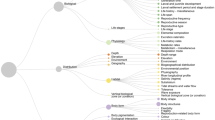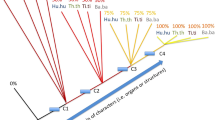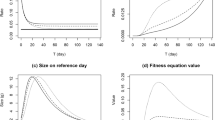Abstract
Vertebrate life histories evolve in response to selection imposed by abiotic and biotic environmental conditions while being limited by genetic, developmental, physiological, demographic and phylogenetic processes that constrain adaptation. Despite the well-recognized shifts in selective pressures accompanying transitions among environments, the conditions driving innovation and the consequences for life-history evolution remain outstanding questions. Here we compare the traits of vertebrates that occupy aquatic or terrestrial environments as juveniles to infer shifts in evolutionary constraints that explain differences in their life-history traits and thus their fundamental demographic rates. Our results emphasize the reduced potential for life-history diversification on land, especially that of reproductive strategies, which limits the scope of viable life-history strategies. Moreover, our study reveals differences between the evolution of viviparity in aquatic and terrestrial realms. Transitions from egg laying to live birth represent a major shift across life-history space for aquatic organisms, whereas terrestrial egg-laying organisms evolve live birth without drastic changes in life-history strategy. Whilst trade-offs in the allocation of resources place fundamental constraints on the way life histories can vary, ecological setting influences the position of species within the viable phenotypic space available for adaptive evolution.
This is a preview of subscription content, access via your institution
Access options
Access Nature and 54 other Nature Portfolio journals
Get Nature+, our best-value online-access subscription
$32.99 / 30 days
cancel any time
Subscribe to this journal
Receive 12 digital issues and online access to articles
$119.00 per year
only $9.92 per issue
Buy this article
- Purchase on SpringerLink
- Instant access to full article PDF
Prices may be subject to local taxes which are calculated during checkout






Similar content being viewed by others
Data availability
The dataset used in this study can be accessed via Zenodo at https://doi.org/10.5281/zenodo.14774608 (ref. 80).
Code availability
The code generated in this study can be accessed via Zenodo at https://doi.org/10.5281/zenodo.14774608 (ref. 80).
References
Blackburn, D. G. Convergent evolution of viviparity, matrotrophy, and specializations for fetal nutrition in reptiles and other vertebrates. Am. Zool. 32, 313–321 (1992).
Wourms, J. P. & Lombardi, J. Reflections on the evolution of piscine viviparity. Am. Zool. 32, 276–293 (1992).
Kalinka, A. T. How did viviparity originate and evolve? Of conflict, co‐option, and cryptic choice. BioEssays 37, 721–731 (2015).
Vági, B. et al. The evolution of parental care in salamanders. Sci. Rep. 12, 16655 (2022).
Gross, M. R. & Sargent, R. C. The evolution of male and female parental care in fishes. Am. Zool. 25, 807–822 (1985).
Farmer, C. G. Parental care: the key to understanding endothermy and other convergent features in birds and mammals. Am. Nat. 155, 326–334 (2000).
Vági, B., Végvári, Z., Liker, A., Freckleton, R. P. & Székely, T. Parental care and the evolution of terrestriality in frogs. Proc. R. Soc. B 286, 20182737 (2019).
Helmstetter, A. J. et al. Viviparity stimulates diversification in an order of fish. Nat. Commun. 7, 11271 (2016).
Reznick, D. N., Travis, J., Pollux, B. J. & Furness, A. I. Reproductive mode and conflict shape the evolution of male attributes and rate of speciation in the fish family Poeciliidae. Front. Ecol. Evol. 9, 639751 (2021).
Miller, A. H., Stroud, J. T. & Losos, J. B. The ecology and evolution of key innovations. Trends Ecol. Evol. 38, 122–131 (2023).
Nuño de la Rosa, L. Agency in reproduction. Evol. Dev. 25, 418–429 (2023).
Blackburn, D. G. in Encyclopedia of Reproduction Vol. 4 (eds Knobil, E. & Neill, J. D.) 994–1003 (Academic Press, 1999).
Recknagel, H., Kamenos, N. A. & Elmer, K. R. Evolutionary origins of viviparity consistent with palaeoclimate and lineage diversification. J. Evol. Biol. 34, 1167–1176 (2021).
Stearns, S. C. The Evolution of Life Histories (Oxford Univ. Press, 1992).
Roff, D. (ed.) Evolution of Life Histories: Theory and Analysis (Springer Science & Business Media, 1993).
Kindsvater, H. K., Mangel, M., Reynolds, J. D. & Dulvy, N. K. Ten principles from evolutionary ecology essential for effective marine conservation. Ecol. Evol. 6, 2125–2138 (2016).
White, C. R., Alton, L. A., Bywater, C. L., Lombardi, E. J. & Marshall, D. J. Metabolic scaling is the product of life-history optimization. Science 377, 834–839 (2022).
Partridge, L. & Harvey, P. H. The ecological context of life history evolution. Science 241, 1449–1455 (1988).
Healy, K., Ezard, T. H. G., Jones, O. R., Salguero-Gómez, R. & Buckley, Y. M. Animal life history is shaped by the pace of life and the distribution of age-specific mortality and reproduction. Nat. Ecol. Evol. 3, 1217–1224 (2019).
Southwood, T. R. E. Tactics, strategies and templets. Oikos 52, 3–18 (1988).
Brown, J. H., Hall, C. A. & Sibly, R. M. Equal fitness paradigm explained by a trade-off between generation time and energy production rate. Nat. Ecol. Evol. 2, 262–268 (2018).
Colbert, E. H. Evolution of the Vertebrates: A History of the Backboned Animals Through Time (John Wiley & Sons, 1955).
Strathmann, R. R. Why life histories evolve differently in the sea. Am. Zool. 30, 197–207 (1990).
Dawson, M. N. & Hamner, W. M. A biophysical perspective on dispersal and the geography of evolution in marine and terrestrial systems. J. R. Soc. Interface 5, 135–150 (2008).
Burgess, S. C., Baskett, M. L., Grosberg, R. K., Morgan, S. G. & Strathmann, R. R. When is dispersal for dispersal? Unifying marine and terrestrial perspectives. Biol. Rev. 91, 867–882 (2016).
Capdevila, P. et al. Longevity, body dimension and reproductive mode drive differences in aquatic versus terrestrial life‐history strategies. Funct. Ecol. 34, 1613–1625 (2020).
Chase, J. M. Are there real differences among aquatic and terrestrial food webs? Trends Ecol. Evol. 15, 408–412 (2000).
Weston, N. H., Vanni, M. J. & Yang, L. H. Comparing resource pulses in aquatic and terrestrial systems. Ecology 89, 647–659 (2008).
Steele, J. H., Brink, K. H. & Scott, B. E. Comparison of marine and terrestrial ecosystems: suggestions of an evolutionary perspective influenced by environmental variation. ICES J. Mar. Sci. 76, 50–59 (2019).
Blackburn, D. G. Evolution of vertebrate viviparity and specializations for fetal nutrition: a quantitative and qualitative analysis. J. Morphol. 276, 961–990 (2015).
Pyron, R. A. & Burbrink, F. T. Early origin of viviparity and multiple reversions to oviparity in squamate reptiles. Ecol. Lett. 17, 13–21 (2014).
Uyeda, J. C., Zenil-Ferguson, R. & Pennell, M. W. Rethinking phylogenetic comparative methods. Syst. Biol. 67, 1091–1109 (2018).
Martin, K. L. & Carter, A. L. Brave new propagules: terrestrial embryos in anamniotic eggs. Integr. Comp. Biol. 53, 233–247 (2013).
Winemiller, K. O. & Rose, K. A. Patterns of life-history diversification in North American fishes: implications for population regulation. Can. J. Fish. Aquat. Sci. 49, 2196–2218 (1992).
Gadgil, M. & Bossert, W. H. Life historical consequences of natural selection. Am. Nat. 104, 1–24 (1970).
Leimar, O. Evolutionary change and Darwinian demons. Selection 2, 65–72 (2002).
Kindsvater, H. K. et al. Overcoming the data crisis in biodiversity conservation. Trends Ecol. Evol. 33, 676–688 (2018).
Charnov, E. L. On evolution of age of maturity and the adult lifespan. J. Evol. Biol. 3, 139–144 (1990).
Charnov, E. L. & Berrigan, D. Dimensionless numbers and life history evolution: age of maturity versus the adult lifespan. Evol. Ecol. 4, 273–275 (1990).
Darwin, C. R. The Descent of Man, and Selection in Relation to Sex 2nd edn (Appleton, 1874).
Williams, G. C. Adaptation and Natural Selection (Princeton Univ. Press, 1966).
Grime, J. P. Vegetation classification by reference to strategies. Nature 250, 26–31 (1974).
Simpson, E. H. The interpretation of interaction in contingency tables. J. R. Stat. Soc. B 13, 238–241 (1951).
Reznick, D., Nunney, L. & Tessier, A. Big houses, big cars, superfleas and the costs of reproduction. Trends Ecol. Evol. 15, 421–425 (2000).
Goodwin, N. B., Dulvy, N. K. & Reynolds, J. D. Life-history correlates of the evolution of live bearing in fishes. Philos. Trans. R. Soc. Lond. B 357, 259–267 (2002).
Winemiller, K. O. Patterns of variation in life history among South American fishes in seasonal environments. Oecologia 81, 225–241 (1989).
Salguero-Gómez, R. et al. Fast–slow continuum and reproductive strategies structure plant life-history variation worldwide. Proc. Natl Acad. Sci. USA 113, 230–235 (2016).
Gross, M. R. & Shine, R. Parental care and mode of fertilization in ectothermic vertebrates. Evolution 35, 775–793 (1981).
Beck, C. W. Mode of fertilization and parental care in anurans. Anim. Behav. 55, 439–449 (1998).
Benun Sutton, F. & Wilson, A. B. Where are all the moms? External fertilization predicts the rise of male parental care in bony fishes. Evolution 73, 2451–2460 (2019).
Orr, T. J. & Brennan, P. L. Sperm storage: distinguishing selective processes and evaluating criteria. Trends Ecol. Evol. 30, 261–272 (2015).
Lyons, K., Kacev, D. & Mull, C. G. An inconvenient tooth: evaluating female choice in multiple paternity using an evolutionarily and ecologically important vertebrate clade. Mol. Ecol. 30, 1574–1593 (2021).
Winemiller, K. O. & Rose, K. A. Why do most fish produce so many tiny offspring? Am. Nat. 142, 585–603 (1993).
Olsson, K. H., Gislason, H. & Andersen, K. H. Differences in density-dependence drive dual offspring size strategies in fish. J. Theor. Biol. 407, 118–127 (2016).
Forster, J., Hirst, A. G. & Atkinson, D. Warming-induced reductions in body size are greater in aquatic than terrestrial species. Proc. Natl Acad. Sci. USA 109, 19310–19314 (2012).
Kuparinen, A. & Festa-Bianchet, M. Harvest-induced evolution: insights from aquatic and terrestrial systems. Philos. Trans. R. Soc. B 372, 20160036 (2017).
Chang, C. C., Moiron, M., Sánchez‐Tójar, A., Niemelä, P. T. & Laskowski, K. L. What is the meta‐analytic evidence for life‐history trade‐offs at the genetic level? Ecol. Lett. 27, e14354 (2023).
Shine, R. The evolution of large body size in females: a critique of Darwin’s “fecundity advantage” model. Am. Nat. 131, 124–131 (1988).
Hedges, S. B., Dudley, J. & Kumar, S. TimeTree: a public knowledge-base of divergence times among organisms. Bioinformatics 22, 2971–2972 (2006).
Rabosky, D. L. et al. An inverse latitudinal gradient in speciation rate for marine fishes. Nature 559, 392–395 (2018).
Zhou, C. F., Wu, S., Martin, T. & Luo, Z. X. A Jurassic mammaliaform and the earliest mammalian evolutionary adaptations. Nature 500, 163–167 (2013).
Upham, N. S., Esselstyn, J. A. & Jetz, W. Inferring the mammal tree: species-level sets of phylogenies for questions in ecology, evolution, and conservation. PLoS Biol. 17, e3000494 (2019).
Jetz, W., Thomas, G. H., Joy, J. B., Hartmann, K. & Mooers, A. O. The global diversity of birds in space and time. Nature 491, 444–448 (2012).
Tonini, J. F. R., Beard, K. H., Ferreira, R. B., Jetz, W. & Pyron, R. A. Fully-sampled phylogenies of squamates reveal evolutionary patterns in threat status. Biol. Conserv. 204, 23–31 (2016).
Jetz, W. & Pyron, R. A. The interplay of past diversification and evolutionary isolation with present imperilment across the amphibian tree of life. Nat. Ecol. Evol. 2, 850–858 (2018).
Thomson, S. A. Turtles of the world: annotated checklist and atlas of taxonomy, synonymy, distribution, and conservation status. Phyllomedusa 20, 225–228 (2021).
Hedges, S. B., Marin, J., Suleski, M., Paymer, M. & Kumar, S. Tree of life reveals clock-like speciation and diversification. Mol. Biol. Evol. 32, 835–845 (2015).
Stein, R. W. et al. Global priorities for conserving the evolutionary history of sharks, rays and chimaeras. Nat. Ecol. Evol. 2, 288–298 (2018).
Froese, R. 1992 Progress Report on FishBase ICLARM Contribution No. 852 (ICLARM, 1992).
Mull, C. G. et al. Sharkipedia: a curated open access database of shark and ray life history traits and abundance time-series. Sci. Data 9, 559 (2022).
Oliveira, B. F., São-Pedro, V. A., Santos-Barrera, G., Penone, C. & Costa, G. C. AmphiBIO, a global database for amphibian ecological traits. Sci. Data 4, 170123 (2017).
Meiri, S. Traits of lizards of the world: variation around a successful evolutionary design. Glob. Ecol. Biogeogr. 27, 1168–1172 (2018).
Myhrvold, N. P. et al. An amniote life‐history database to perform comparative analyses with birds, mammals, and reptiles. Ecology 96, 3109–3109 (2015).
Abrams, P. A. & Rowe, L. The effects of predation on the age and size of maturity of prey. Evolution 50, 1052–1061 (1996).
Sharpe, D. M. & Hendry, A. P. Life history change in commercially exploited fish stocks: an analysis of trends across studies. Evol. Appl. 2, 260–275 (2009).
Goolsby, E. W., Ane, C. & Bruggeman, J. Rphylopars: fast multivariate phylogenetic comparative methods for missing data and within-species variation. Methods Ecol. Evol. 8, 22–27 (2017).
Revell, L. J. phytools 2.0: an updated R ecosystem for phylogenetic comparative methods (and other things). PeerJ 12, e16505 (2024).
Ives, A. R. & Li, D. rr2: an R package to calculate R2s for regression models. J. Open Source Softw. 3, 1028 (2018).
R Core Team R: A Language and Environment for Statistical Computing (R Foundation for Statistical Computing, 2024); https://www.R-project.org/
Brooks, G. C. et al. geobro1992/VTparity: Code for: Fundamental constraints on vertebrate life history are shaped by aquatic-terrestrial transitions and reproductive mode. Zenodo https://doi.org/10.5281/zenodo.14774608 (2025).
Smith, M. R. ms609/Ternary: v2.3.3. Zenodo https://doi.org/10.5281/zenodo.1068996 (2017).
Acknowledgements
We would like to thank J. Berman and T. Stephenson for help compiling trait data. We would like to thank the Department of Fish and Wildlife Conservation and the Department of Biological Sciences at Virginia Tech for financial and logistical support.
Author information
Authors and Affiliations
Contributions
G.C.B. and H.K.K. conceived the idea. G.C.B., H.M.C. and C.G.M. compiled and proofed the data. J.C.U. designed the analyses. G.C.B., J.C.U. and N.J.B. performed the analyses and confirmed the reproducibility of the code and results. G.C.B., J.C.U. and H.K.K. wrote the manuscript. All authors revised and approved the final manuscript.
Corresponding author
Ethics declarations
Competing interests
The authors declare no competing interests.
Peer review
Peer review information
Nature Ecology & Evolution thanks Pol Capdevila, R. Alexander Pyron and the other, anonymous, reviewer(s) for their contribution to the peer review of this work.
Additional information
Publisher’s note Springer Nature remains neutral with regard to jurisdictional claims in published maps and institutional affiliations.
Extended data
Extended Data Fig. 1 Distribution of vertebrate body sizes and mortality rates across egg-laying and live-bearing taxa.
Distribution of egg-laying (turquoise) and live-bearing (orange) vertebrate a) body sizes, b) juvenile mortality, and c) adult mortality. Points are colored by reproductive mode. The number of species in each clade for which trait data is available is provided at the bottom of the panel.
Extended Data Fig. 2 Distribution of aquatic and terrestrial species in relation to body size and adult mortality, for different levels of lifetime reproductive output (LRO).
Adult mortality is estimated as the inverse of age at maturity, and lifetime reproductive output is the product of clutch size, longevity, and the frequency of reproductive bouts. Points are colored by reproductive mode.
Extended Data Fig. 3 The relationship between body size and juvenile mortality, adult mortality, and lifetime mortality for aquatic and terrestrial species.
The relationship between body size and juvenile mortality, adult mortality, and lifetime mortality for aquatic (green) and terrestrial (orange) species. This figure is equivalent to Fig. 3 in the main text except that predictions from the linear regressions are corrected for phylogeny using the phylolm package.
Extended Data Fig. 4 Data coverage across vertebrate clades.
Bars show the proportion of species with published information on terrestriality, parity mode, body size, lifetime reproductive output (juvenile mortality), and age at maturity (adult mortality).
Extended Data Fig. 5 A conceptual diagram of the discrete-space evolutionary model in ternary space.
In this modelling framework, species can evolve to neighboring patches within the defined life-history space or can transition between states. The two state spaces (triangles) can represent egg-laying and live-bearing reproductive modes or aquatic and terrestrial environments.
Supplementary information
Supplementary Information
Supplementary Methods, Supplementary Table 1 and Supplementary Figs. 1–3.
Rights and permissions
Springer Nature or its licensor (e.g. a society or other partner) holds exclusive rights to this article under a publishing agreement with the author(s) or other rightsholder(s); author self-archiving of the accepted manuscript version of this article is solely governed by the terms of such publishing agreement and applicable law.
About this article
Cite this article
Brooks, G.C., Uyeda, J.C., Bone, N.J. et al. Fundamental constraints on vertebrate life history are shaped by aquatic–terrestrial transitions and reproductive mode. Nat Ecol Evol 9, 857–866 (2025). https://doi.org/10.1038/s41559-025-02663-1
Received:
Accepted:
Published:
Issue date:
DOI: https://doi.org/10.1038/s41559-025-02663-1



